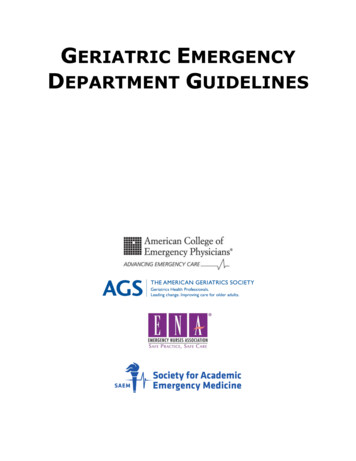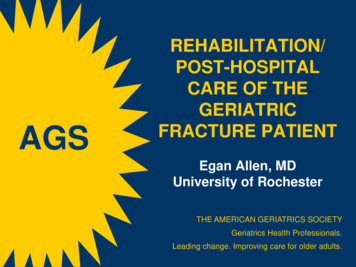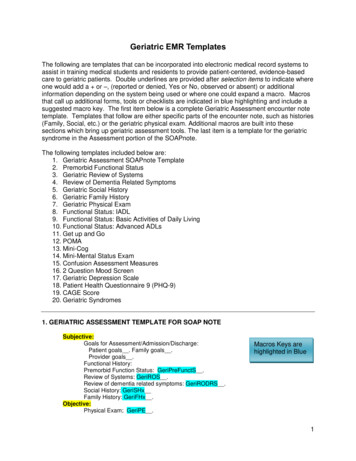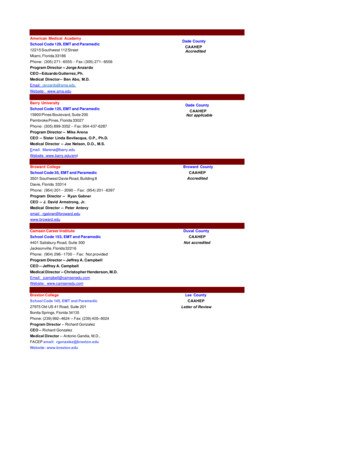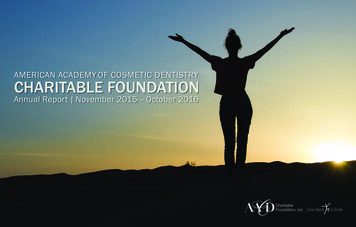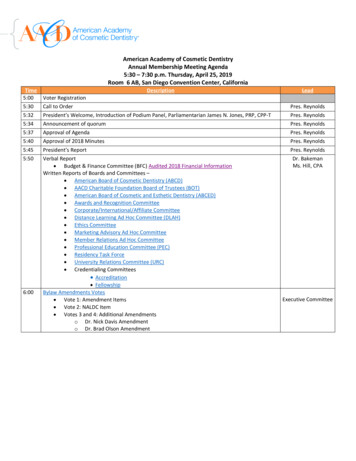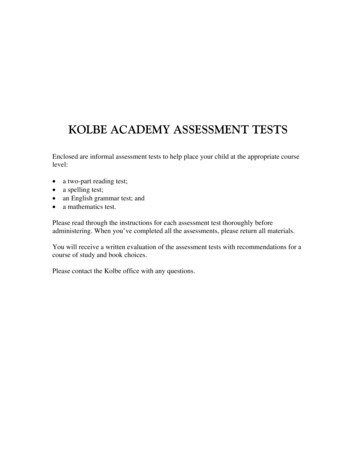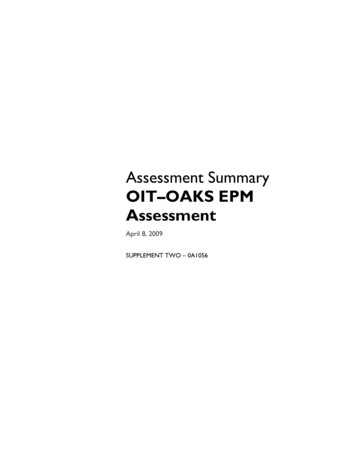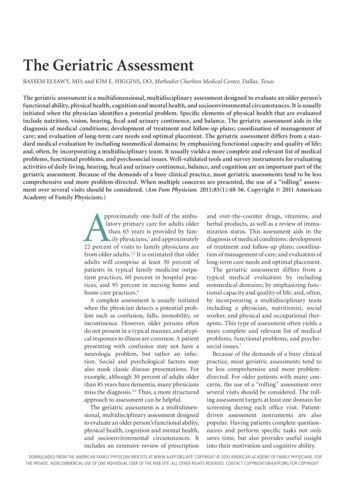
Transcription
The Geriatric AssessmentBASSEM ELSAWY, MD, and KIM E. HIGGINS, DO, Methodist Charlton Medical Center, Dallas, TexasThe geriatric assessment is a multidimensional, multidisciplinary assessment designed to evaluate an older person’sfunctional ability, physical health, cognition and mental health, and socioenvironmental circumstances. It is usuallyinitiated when the physician identifies a potential problem. Specific elements of physical health that are evaluatedinclude nutrition, vision, hearing, fecal and urinary continence, and balance. The geriatric assessment aids in thediagnosis of medical conditions; development of treatment and follow-up plans; coordination of management ofcare; and evaluation of long-term care needs and optimal placement. The geriatric assessment differs from a standard medical evaluation by including nonmedical domains; by emphasizing functional capacity and quality of life;and, often, by incorporating a multidisciplinary team. It usually yields a more complete and relevant list of medicalproblems, functional problems, and psychosocial issues. Well-validated tools and survey instruments for evaluatingactivities of daily living, hearing, fecal and urinary continence, balance, and cognition are an important part of thegeriatric assessment. Because of the demands of a busy clinical practice, most geriatric assessments tend to be lesscomprehensive and more problem-directed. When multiple concerns are presented, the use of a “rolling” assessment over several visits should be considered. (Am Fam Physician. 2011;83(1):48-56. Copyright 2011 AmericanAcademy of Family Physicians.)Approximately one-half of the ambulatory primary care for adults olderthan 65 years is provided by fam ily physicians,1 and approximately22 percent of visits to family physicians arefrom older adults.2,3 It is estimated that olderadults will comprise at least 30 percent ofpatients in typical family medicine outpatient practices, 60 percent in hospital practices, and 95 percent in nursing home andhome care practices.4A complete assessment is usually initiatedwhen the physician detects a potential problem such as confusion, falls, immobility, orincontinence. However, older persons oftendo not present in a typical manner, and atypical responses to illness are common. A patientpresenting with confusion may not have aneurologic problem, but rather an infection. Social and psychological factors mayalso mask classic disease presentations. Forexample, although 30 percent of adults olderthan 85 years have dementia, many physiciansmiss the diagnosis.5,6 Thus, a more structuredapproach to assessment can be helpful.The geriatric assessment is a multidimensional, multidisciplinary assessment designedto evaluate an older person’s functional ability,physical health, cognition and mental health,and socioenvironmental circumstances. Itincludes an extensive review of prescriptionand over-the-counter drugs, vitamins, andherbal products, as well as a review of immunization status. This assessment aids in thediagnosis of medical conditions; developmentof treatment and follow-up plans; coordination of management of care; and evaluation oflong-term care needs and optimal placement.The geriatric assessment differs from atypical medical evaluation by includingnonmedical domains; by emphasizing functional capacity and quality of life; and, often,by incorporating a multidisciplinary teamincluding a physician, nutritionist, socialworker, and physical and occupational therapists. This type of assessment often yields amore complete and relevant list of medicalproblems, functional problems, and psychosocial issues.7Because of the demands of a busy clinicalpractice, most geriatric assessments tend tobe less comprehensive and more problemdirected. For older patients with many concerns, the use of a “rolling” assessment overseveral visits should be considered. The rolling assessment targets at least one domain forscreening during each office visit. Patientdriven assessment instruments are alsopopular. Having patients complete questionnaires and perform specific tasks not onlysaves time, but also provides useful insightinto their motivation and cognitive ability.DOWNLOADED FROM THE AMERICAN FAMILY PHYSICIAN WEB SITE AT WWW.AAFP.ORG/AFP. COPYRIGHT 2010 AMERICAN ACADEMY OF FAMILY PHYSICIANS. FOR48Family PhysicianVolume83, Number 1 January1, 2011THE AmericanPRIVATE, NONCOMMERCIALUSE OF ONE INDIVIDUAL USER OF THE www.aafp.org/afpWEB SITE. ALL OTHER RIGHTS RESERVED. CONTACTCOPYRIGHTS@AAFP.ORGFOR COPYRIGHT
Geriatric AssessmentSORT: KEY RECOMMENDATIONS FOR PRACTICEClinical recommendationThe U.S. Preventive Services Task Force found insufficient evidence to recommend for or againstscreening with ophthalmoscopy in asymptomatic older patients.Patients with chronic otitis media or sudden hearing loss, or who fail any hearing screening testsshould be referred to an otolaryngologist.Hearing aids are the treatment of choice for older patients with hearing impairment, because theyminimize hearing loss and improve daily functioning.The U.S. Preventive Services Task Force has advised routinely screening women 65 years and older forosteoporosis with dual-energy x-ray absorptiometry of the femoral neck.The Centers for Medicare and Medicaid Services encourages the use of the Beers criteria as part ofan older patient’s medication assessment to reduce adverse effects.EvidenceratingReferencesC15C21, 23A23A37C39, 40A consistent, good-quality patient-oriented evidence; B inconsistent or limited-quality patient-oriented evidence; C consensus, disease-orientedevidence, usual practice, expert opinion, or case series. For information about the SORT evidence rating system, go to http://www.aafp.org/afpsort.xml.Functional AbilityFunctional status refers to a person’s ability to performtasks that are required for living. The geriatric assessmentbegins with a review of the two key divisions of functionalability: activities of daily living (ADL) and instrumentalactivities of daily living (IADL). ADL are self-care activitiesthat a person performs daily (e.g., eating, dressing, bathing, transferring between the bed and a chair, using thetoilet, controlling bladder and bowel functions). IADL areactivities that are needed to live independently (e.g., doinghousework, preparing meals, taking medications properly,managing finances, using a telephone). Physicians canacquire useful functional information by simply observing older patients as they complete simple tasks, such asunbuttoning and buttoning a shirt, picking up a pen andwriting a sentence, taking off and putting on shoes, andclimbing up and down from an examination table. Twoinstruments for assessing ADL and IADL include the KatzADL scale (Table 1) 8 and the Lawton IADL scale (Table 2).9Deficits in ADL and IADL can signal the need for morein-depth evaluation of the patient’s socioenvironmentalcircumstances and the need for additional assistance.Table 1. Katz Index of Independence in Activities of Daily LivingActivities (1 or 0 points)Independence (1 point)*Dependence (0 points)†BathingPoints:Bathes self completely or needs help in bathing onlya single part of the body, such as the back, genitalarea, or disabled extremityDressingPoints:Gets clothes from closets and drawers, and putson clothes and outer garments complete withfasteners; may need help tying shoesGoes to toilet, gets on and off, arranges clothes,cleans genital area without helpNeeds help with bathing more than onepart of the body, getting in or out ofthe bathtub or shower; requires totalbathingNeeds help with dressing self or needsto be completely dressedToiletingPoints:TransferringPoints:Fecal and urinary continencePoints:FeedingPoints:Moves in and out of bed or chair unassisted;mechanical transfer aids are acceptableNeeds help transferring to the toiletand cleaning self, or uses bedpan orcommodeNeeds help in moving from bed to chairor requires a complete transferExercises complete self-control over urination anddefecationIs partially or totally incontinent ofbowel or bladderGets food from plate into mouth without help;preparation of food may be done by another personNeeds partial or total help with feedingor requires parenteral feedingTotal points‡:*—No supervision, direction, or personal assistance.†—With supervision, direction, personal assistance, or total care.‡—Score of 6 high (patient is independent); score of 0 low (patient is very dependent).Adapted with permission from Katz S, Downs TD, Cash HR, Grotz RC. Progress in development of the index of ADL. Gerontologist. 1970;10(1):23.January 1, 2011 Volume 83, Number 1www.aafp.org/afp American Family Physician 49
Geriatric AssessmentTable 2. Lawton Instrumental Activities of Daily LivingScale (Self-Rated Version)For each question, circle the points for the answer that best appliesto your situation.1. Can you use the telephone?Without help3With some help2Completely unable to use the telephone12. Can you get to places that are out of walking distance?Without help3With some help2Completely unable to travel unless special arrangements are made13. Can you go shopping for groceries?Without help3With some help2Completely unable to do any shopping14. Can you prepare your own meals?Without help3With some help2Completely unable to prepare any meals15. Can you do your own housework?Without help3With some help2Completely unable to do any housework16. Can you do your own handyman work?Without help3With some help2Completely unable to do any handyman work17. Can you do your own laundry?Without help3With some help2Completely unable to do any laundry18a. Do you use any medications?Yes (If “yes,” answer question 8b)1No (If “no,” answer question 8c)28b. Do you take your own medication?Without help (in the right doses at the right time)3W ith some help (take medication if someone prepares it for you2or reminds you to take it)Completely unable to take own medication18c. If you had to take medication, could you do it?Without help (in the right doses at the right time)3W ith some help (take medication if someone prepares it for you2or reminds you to take it)Completely unable to take own medication19. Can you manage your own money?Without help3With some help2Completely unable to handle money1Scores have meaning only for a particular patient (e.g., declining scores overtime reveal deterioration). Some questions may be sex-specific and can be modifiedby the interviewer.NOTE:Adapted with permission from Lawton MP, Brody EM. Assessment of older people: selfmaintaining and instrumental activities of daily living. Gerontologist. 1969;9(3):181.50 American Family Physicianwww.aafp.org/afpPhysical HealthThe geriatric assessment incorporates all facets of a conventional medical history, including main problem, current illness, past andcurrent medical problems, family and socialhistory, demographic data, and a review ofsystems. The approach to the history andphysical examination, however, should bespecific to older persons. In particular, topics such as nutrition, vision, hearing, fecaland urinary continence, balance and fallprevention, osteoporosis, and polypharmacyshould be included in the evaluation. Table 3is an example of a focused geriatric physicalexamination.SCREENING FOR DISEASEIn the normal aging process, there is often adecline in physiologic function that is usually not disease-related. However, treatmentof diabetes mellitus, hypertension, and glaucoma can prevent significant future morbidity. Screening for malignancies may allowfor early detection, and some are curable iftreated early. It is important that physiciansweigh the potential harms of screening beforescreening older patients. It is essential toconsider family preferences regarding treatment if a disease is detected, and the patient’sfunctional status, comorbid conditions, andpredicted life expectancy. If an asymptomatic patient has an expected survival of morethan five years, screening is generally medically warranted, assuming that the patient isat risk of the disease and would accept treatment if early disease was detected.10,11The Agency for Healthcare Research andQuality has developed an online tool calledthe Electronic Preventive Services Selector (http://epss.ahrq.gov/ePSS/search.jsp)that can be downloaded to smartphones.It can assist physicians in identifying ageappropriate screening measures.NUTRITIONA nutritional assessment is importantbecause inadequate micronutrient intakeis common in older persons. Several agerelated medical conditions may predisposepatients to vitamin and mineral deficiencies.Studies have shown that vitamins A, C, D,Volume 83, Number 1 January 1, 2011
Geriatric AssessmentTable 3. Sample Focused Geriatric Physical ExaminationSignsPhysical sign or symptomDifferential diagnosesHypertensionOrthostatic hypotensionBradycardiaIrregularly irregular heart rateIncreased respiratory rate greaterthan 24 breaths per minuteHyperthermia, hypothermiaAdverse effects from medication, autonomic dysfunctionAdverse effects from medication, atherosclerosis, coronary artery diseaseAdverse effects from medication, heart blockAtrial fibrillationChronic obstructive pulmonary disease, congestive heart failure,pneumoniaHyper- and hypothyroidism, infectionGeneralUnintentional weight lossWeight gainCancer, depressionAdverse effects from congestive heart failure medicationHeadAsymmetric facial or extraocularmuscle weakness or paralysisFrontal bossingTemporal artery tendernessBell palsy, stroke, transient ischemic attackEyesEye painImpaired visual acuityLoss of central visionLoss of peripheral visionOcular lens opacificationGlaucoma, temporal arteritisPresbyopiaAge-related macular degenerationGlaucoma, strokeCataractsEarsHearing lossAcoustic neuroma, adverse effects from medication, cerumenimpaction, faulty or ill-fitting hearing aids, Paget diseaseMouth, throatGum or mouth soresLeukoplakiaXerostomiaDental or periodontal disease, ill-fitting denturesCancerous and precanc
01.01.2011 · 6. Can you do your own handyman work? Without help With some help Completely unable to do any handyman work 3 2 1 7. Can you do your own laundry? Without help With some help Completely unable to .
